-
 Iron tsuba of oval form with design of a gourd or aubergine vine with fruits, leaves, and blossoms climbing a trellis, and a fence in yellow brass and red copper flat inlay (hira-zōgan); inlay engraved. Two latticed windows represented by openwork (sukashi). The iron web has deep black patina. The seller attributes this tsuba to Heianjo-Namban school, whatever it means. Momoyama or early Edo period, 17th century. Kaga or Heianjō School. Unsigned. Height: 77.3, Width: 73.1, Thickness at seppa-dai: 3.6 mm.
Iron tsuba of oval form with design of a gourd or aubergine vine with fruits, leaves, and blossoms climbing a trellis, and a fence in yellow brass and red copper flat inlay (hira-zōgan); inlay engraved. Two latticed windows represented by openwork (sukashi). The iron web has deep black patina. The seller attributes this tsuba to Heianjo-Namban school, whatever it means. Momoyama or early Edo period, 17th century. Kaga or Heianjō School. Unsigned. Height: 77.3, Width: 73.1, Thickness at seppa-dai: 3.6 mm. -
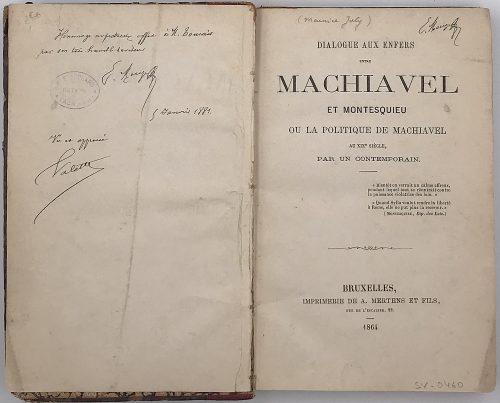 Title page: DIALOGUE AUX ENFERS | ENTRE | MACHIAVEL | ET MONTESQUIEU | OU LA POLITIQUE DE MACHIAVEL | AU XIXe SIÈCLE, | PAR UN CONTEMPORAIN. | {6 lines of citations} | ~ | BRUXELLES, | IMPRIMERIE DE A. MERTENS ET FILS, | RUE DE L’ESCALIER, 22. | 1864 ||
Title page: DIALOGUE AUX ENFERS | ENTRE | MACHIAVEL | ET MONTESQUIEU | OU LA POLITIQUE DE MACHIAVEL | AU XIXe SIÈCLE, | PAR UN CONTEMPORAIN. | {6 lines of citations} | ~ | BRUXELLES, | IMPRIMERIE DE A. MERTENS ET FILS, | RUE DE L’ESCALIER, 22. | 1864 ||Description: 17.9 x 12 cm, quarter red morocco over marbled boards, spine with raised bands, gilt bees in compartments, gilt lettering, marbled endpapers, ffep cut out top 1/4, ffep and h.t. loose.
Collation: 12mo; fep, π4 1-2712, 292, fep.; total 174 leaves. Pagination: [2 h.t] [2 t.p.] [i] ii-iii [iv] [1] 2-337 [338] [2 errata].Inscriptions and markings: "Hommage respectueux offert à M. Bourdais par son très humble serviteur, 5 Janvier 1881". Signature: E. Rouger (?) "Vu et approuvé". "Valatte". Ink stamp: "M<aîtr>e E. Brouard - Notaire a Laon Aisne".
Other copies: LIB-1034.2016 and LIB-2913.2021. Other related objects: SVVP-0062.2021. The publication was funded by the author and smuggled into France. Contributors: Maurice Joly (French, 1829 – 1878) -
 Katsukawa Shunshō ( 勝川 春章; 1726 – 19 January 1793).
Katsukawa Shunshō ( 勝川 春章; 1726 – 19 January 1793).SIZE: 12.5 x 5.75 in.
-
 Iron tsuba of mokko form (quatrefoil) decorated with a pair of cherry blossoms (sakura) in small openwork (ko-sukashi) and inlaid in brass (suemon-zōgan) with designs of waves, distant pines, chrysanthemum flowers in halves, tendrils and leaves, lightning or thunder symbol (inazuma), flying geese and family chrests (mon): two interlocked rings (wachigai) on the face, and three encircled stripes (maru-no-uchi-ni-mitsuhikiryo) - kamon of the Kikkawa clan - on the reverse. Hitsu-ana outlined with inlay of brass wire. Surface treated with lacquer. Copper sekigane. Though some consider this type of tsuba to resemble Heianjo school, “...the brass trim around the hitsu-ana is a characteristics of Ōnin work” [Japanese sword guards. Onin – Heianjo – Yoshiro. Gary D. Murtha. GDM Publications, 2016; p. 27.]. The Ōnin origin is reinforced by scattered ten-zōgan elements here and there through the plate. It is possible that the tsuba was initially of round form and later trimmed to mokko shape. Mid Muromachi period; 15th century. Dimensions: Height: 87.2 mm; Width: 87.9 mm; Thickness at seppa-dai: 3.6 mm.
Iron tsuba of mokko form (quatrefoil) decorated with a pair of cherry blossoms (sakura) in small openwork (ko-sukashi) and inlaid in brass (suemon-zōgan) with designs of waves, distant pines, chrysanthemum flowers in halves, tendrils and leaves, lightning or thunder symbol (inazuma), flying geese and family chrests (mon): two interlocked rings (wachigai) on the face, and three encircled stripes (maru-no-uchi-ni-mitsuhikiryo) - kamon of the Kikkawa clan - on the reverse. Hitsu-ana outlined with inlay of brass wire. Surface treated with lacquer. Copper sekigane. Though some consider this type of tsuba to resemble Heianjo school, “...the brass trim around the hitsu-ana is a characteristics of Ōnin work” [Japanese sword guards. Onin – Heianjo – Yoshiro. Gary D. Murtha. GDM Publications, 2016; p. 27.]. The Ōnin origin is reinforced by scattered ten-zōgan elements here and there through the plate. It is possible that the tsuba was initially of round form and later trimmed to mokko shape. Mid Muromachi period; 15th century. Dimensions: Height: 87.2 mm; Width: 87.9 mm; Thickness at seppa-dai: 3.6 mm. -
 Shingen school tsuba with woven wire pattern. Iron core, woven brass wire. Height: 72.5 mm; Width 69.8 mm; Thickness at seppa-dai: 4.0 mm. Weight 88.8 g. Late Muromachi, 16th century. SOLD http://varshavskycollection.com/shingen-tsuba/
Shingen school tsuba with woven wire pattern. Iron core, woven brass wire. Height: 72.5 mm; Width 69.8 mm; Thickness at seppa-dai: 4.0 mm. Weight 88.8 g. Late Muromachi, 16th century. SOLD http://varshavskycollection.com/shingen-tsuba/ -
 Similar image at MFA under title: Actors and Women in the Snow MFA ACCESSION NUMBER: 11.13568 Date: 1809 (Bunka 6), 12th month Artist: Utagawa Toyokuni I (1769–1825) Publisher Tsuruya Kinsuke (firm name Sôkakudô), № 554 in Marks's "Publishers". DIMENSIONS: Vertical ôban; 38.2 x 25.8 cm (15 1/16 x 10 3/16 in.) MEDIUM OR TECHNIQUE: Woodblock print (nishiki-e); ink and color on paper. Signed: Toyokuni ga (豊国画) Censor's seals: kiwame (改印:極) MFA assumes that this may be "one sheet of incomplete triptych?"
Similar image at MFA under title: Actors and Women in the Snow MFA ACCESSION NUMBER: 11.13568 Date: 1809 (Bunka 6), 12th month Artist: Utagawa Toyokuni I (1769–1825) Publisher Tsuruya Kinsuke (firm name Sôkakudô), № 554 in Marks's "Publishers". DIMENSIONS: Vertical ôban; 38.2 x 25.8 cm (15 1/16 x 10 3/16 in.) MEDIUM OR TECHNIQUE: Woodblock print (nishiki-e); ink and color on paper. Signed: Toyokuni ga (豊国画) Censor's seals: kiwame (改印:極) MFA assumes that this may be "one sheet of incomplete triptych?" -

Kyo school iron tsuba of round form decorated with an eight-plank bridge (yatsuhashi) and irises (kakitsubata) in openwork (sukashi).
Late Muromachi period, Tenbun era (early 16th centiry).Dimensions: 80.0 x 77.2 x 4.1 mm.
The design alludes to the scene in 'Ise Monogatari', where Ariwara no Narihira being exiled from Kyoto to the Kanto region crossed the eight-plank bridge at Mikawa looking at the irises in bloom and composed a poem expressing his desire to return to Kyoto. A lot of tsuba have been produced with the similar design.
Reference: Masterpieces from the Sasano collection, 1994, p. 98, №69. -
 Iron tsuba of round form with a dense combination of symbols: slanting rays of light (shakoh) Christian motif (Jesuit's IHS symbol), also often described as "tokei" or "clock gear", wild goose in flight, bracken, and lozenges in openwork (sukashi). Copper sekigane. Edo period.
Iron tsuba of round form with a dense combination of symbols: slanting rays of light (shakoh) Christian motif (Jesuit's IHS symbol), also often described as "tokei" or "clock gear", wild goose in flight, bracken, and lozenges in openwork (sukashi). Copper sekigane. Edo period.Size: 76.0 x 72.6 x 6.2 mm
Unsigned.
For information regarding shakoh tsuba see article 'Kirishitan Ikenie Tsuba by Fred Geyer at Kokusai Tosogu Kai; The 2nd International Convention & Exhibition, October 18-23, 2006, pp. 84-91.
-
 Torii Kiyonaga (鳥居 清長; 1752 – June 28, 1815) Signed: Kiyonaga ga (清長画)
Torii Kiyonaga (鳥居 清長; 1752 – June 28, 1815) Signed: Kiyonaga ga (清長画)References: No references whatsoever, not in Pins.
-
 Le Petit Chaperon rouge (Little Red Riding Hood), three wood engravings by Gustave Doré, 1864: "En passant dans un bois elle rencontra compère le Loup"; "Le Chaperon rouge fut bien étonné de voir comment sa grand'mère était faite en son déshabillé"; "Cela n'empêche pas qu'avec ses gran dents il avait mangé une bonne grand'mère". Engraved by Adolphe Pannemaker. Le Petit Poucet (Little Thumb), one wood engraving by Gustave Doré, 1864: "Une bonne femme vint leur ouvrir". Engraved by Héliodore-Joseph Pisan. La Belle au bois dormant (Sleeping Beauty), one wood engraving by Gustave Doré, 1864: "Il marcha vers le château qu'il voyait au bout d'une grande avenue où il entra". Engraved by Héliodore-Joseph Pisan. Medium: Paper; Wood engraving. Illustrations for P.-J. Hetzel's edition of Perrault's Fairy Tales (Les Contes de Perrault) by Gustave Doré published in 1864. Size: frame: 428 x 302 mm; sheet: 280 x 231 mm; image: 194 x 244 mm.
Le Petit Chaperon rouge (Little Red Riding Hood), three wood engravings by Gustave Doré, 1864: "En passant dans un bois elle rencontra compère le Loup"; "Le Chaperon rouge fut bien étonné de voir comment sa grand'mère était faite en son déshabillé"; "Cela n'empêche pas qu'avec ses gran dents il avait mangé une bonne grand'mère". Engraved by Adolphe Pannemaker. Le Petit Poucet (Little Thumb), one wood engraving by Gustave Doré, 1864: "Une bonne femme vint leur ouvrir". Engraved by Héliodore-Joseph Pisan. La Belle au bois dormant (Sleeping Beauty), one wood engraving by Gustave Doré, 1864: "Il marcha vers le château qu'il voyait au bout d'une grande avenue où il entra". Engraved by Héliodore-Joseph Pisan. Medium: Paper; Wood engraving. Illustrations for P.-J. Hetzel's edition of Perrault's Fairy Tales (Les Contes de Perrault) by Gustave Doré published in 1864. Size: frame: 428 x 302 mm; sheet: 280 x 231 mm; image: 194 x 244 mm. -

Iron tsuba with chrysanthemum design in openwork (sukashi). Copper sekigane.
Late Heian through Kamakura period (ca. 1150 - 1200's).
Size: 78.4 x 60.9 x 3.5 mm; weight: 45.7 g
Provenance: Boris Markhasin Message from Boris Markhasin (13-AUG-2019): It is a very rudimentary tachi tsuba, and the iron is old and really nothing to draw attention. However, this is a very old tsuba, and that is what makes it very special and an important study piece. This tsuba likely dates to the late Heian through Kamakura (ca. 1150 - 1200's) -- by consensus, since such examples are extremely rare, and none are mounted to my knowledge, so few direct analogues. The form is interesting for a variety of reasons. The smaller size, an oval form is associated more with 12th/13th c styles. The sukashi kiku motif is very interesting as it clearly pushes back the dating of large scale sukashi far back in time. This shouldn't be surprising, but for some reason, we (really mainly westerners) naively tend to associate sukashi with the Muromachi and younger. The two missing spokes are by consensus likely later removals to accommodate kozuka and kogai -- but this is not certain, and it could be an original styling. A key kantei point is the elongate, narrow, slightly squared seppa dai. This is a characteristic of early koshirae, which were much thinner and more delicate than the types we are used to seeing that date pretty much to the late Muromachi and later. I am always amazed when I have a chance to interrogate early koshirae at how thin they are - I want to call them fragile, but they were actually quite resilient. The walls were super thin, but the top and bottom edges were a bit thicker, providing a bit of structural support... but this is another thread topic. Of all the tsuba I have owned, this is the tsuba that has most clearly reflected the shape of the old style of saya / tsuka. -
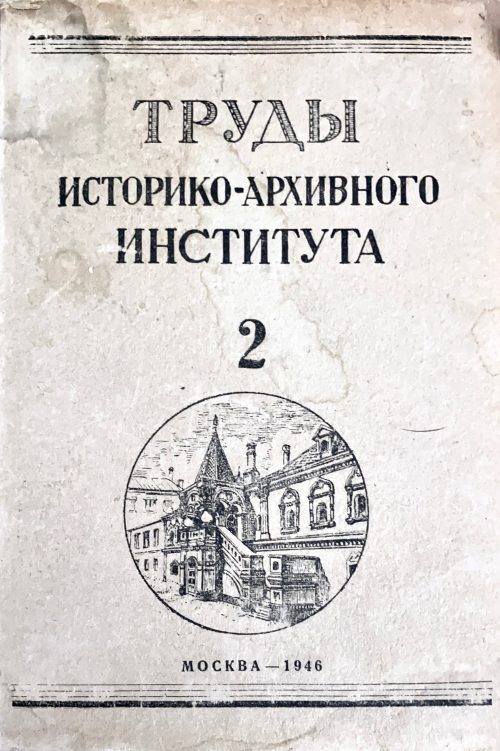 Елизавета Николаевна Данилова. "Завещание" Петра Великого / Под ред. Александр Игнатьевич Андреева. // В сборнике: Труды Историко-архивного института, том 2, 1946. (Кафедра вспомогательных исторических дисциплин). – с. 202-270. Москва: Главное архивное управление МВД Союза ССР. Историко-архивный институт, 1946. Тираж: 3000 экз.
Елизавета Николаевна Данилова. "Завещание" Петра Великого / Под ред. Александр Игнатьевич Андреева. // В сборнике: Труды Историко-архивного института, том 2, 1946. (Кафедра вспомогательных исторических дисциплин). – с. 202-270. Москва: Главное архивное управление МВД Союза ССР. Историко-архивный институт, 1946. Тираж: 3000 экз. -
 Artist: Utagawa Kuniyoshi [歌川 國芳] (Japanese, 1798 – 1861).
Artist: Utagawa Kuniyoshi [歌川 國芳] (Japanese, 1798 – 1861).Title: Suzume fukube [美人団扇絵] (Sparrow and gourds).
Series: Kacho awase [花鳥合] (Collection of flowers and birds).
Publisher: Aritaya Seiemon [有田屋 清右衛門] (Japanese, fl. c. 1830 – 1862); Seal: Marks 17-011 | 014d.Signed: Ichiyosai Kuniyoshi ga in a red cartouche and sealed with paulownia crest (kiri mon).
Size: Uchiwa-e (untrimmed fan print) 296 x 230 mm.
Double nanushi censor seals: Kinugasa & Watanabe, Kaei 2-3 (1849–50).
Ref.: Kuniyoshi Project. -
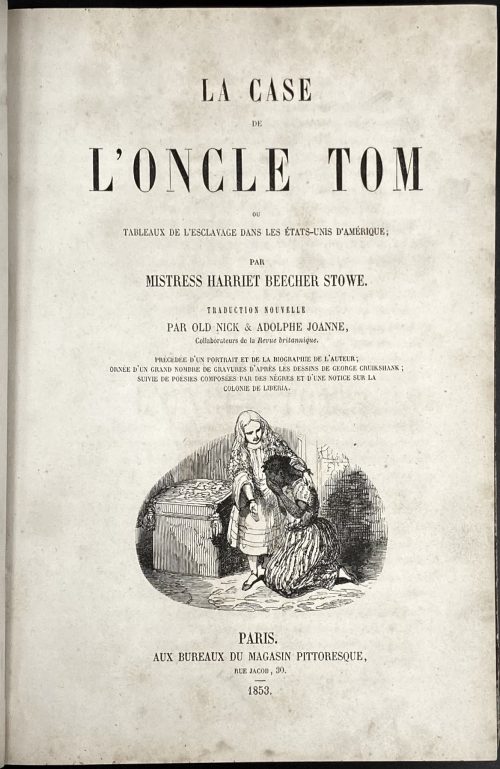 1st French edition (Paris, 1853) of Harriet Beecher Stowe's book Uncle Tom's Cabin; or, Life Among the Lowly, with 27 illustrations on wood by George Cruikshank (British, 1792 – 1878), translated into French by Paul-Émile Daurand-Forgues [pseudonym Old Nick] (French, 1813 – 1883) and Adolphe Joanne (French, 1813 – 1881). Title: LA CASE | DE | L'ONCLE TOM | OU | TABLE AUX DE L'ESCLAVAGE DANS LES ÉTATS-UNIS D'AMÉRIQUE ; | PAR MISTRESS HARRIET BEECHER STOWE. | TRADUCTION NOUVELLE | PAR OLD NICK & ADOLPHE JOANNE, | Collaboarteurs de la Revue britannique, | PRÉCÉDÉE D'UN PORTRAIT ET DE LA BIOGRAPHIE DE L'AUTEUR; | ORNÉE D'IU GRAND NOMBRE DE GRAVURES D'APRES LES DESSINS DE GEORGE CRUIKSHANK ; | SUIVIE DE POÉSIES COMPOSÉES PAR DES NÈGRES ET D'UNE NOTICE SUR LA | COLONIE DE LIBERIA. | [vignette] | PARIS. | AUX BUREAUX DU MAGASIN PITTORESQUE, | RUE JACOB, 30. | 1853. Pagination: ffl blank; [i-ii]: h.t. with stamped letters D. W. in the upper centre / imprim. to verso; [iii-iv] t.p. / blank; [v-vi] blank / frontispiece: portrait of Harriet Beecher Stowe, half-length to left, with hair in ringlets, and a shawl over shoulders, landscape behind, Henry Linton (British, 1815 – 1899) after Henry Anelay (British,1817 – 1883), wood-engraving with letterpress; [vij] Viij-xij; [1] 2-563 [564]; bfl blank; illustrations: 27 woodcuts by George Cruikshank. Collation: 8vo, π7 (1)–(35)8 363 Binding: Quarter brown calf, spine with raised bands, gilt-ruled compartments, title lettering, "D. W." in the bottom, marbled boards and endpapers. Dimensions: 24.1 x 16.4 cm. Catalogue raisonné: Albert M. Cohen (1924), №777, p. 221. "An edition was published in French with the woodcuts direct from the blocks, not, as in the English, merely from the stereotypes. The illustrations are far more impressive than those of Cassell's edition".
1st French edition (Paris, 1853) of Harriet Beecher Stowe's book Uncle Tom's Cabin; or, Life Among the Lowly, with 27 illustrations on wood by George Cruikshank (British, 1792 – 1878), translated into French by Paul-Émile Daurand-Forgues [pseudonym Old Nick] (French, 1813 – 1883) and Adolphe Joanne (French, 1813 – 1881). Title: LA CASE | DE | L'ONCLE TOM | OU | TABLE AUX DE L'ESCLAVAGE DANS LES ÉTATS-UNIS D'AMÉRIQUE ; | PAR MISTRESS HARRIET BEECHER STOWE. | TRADUCTION NOUVELLE | PAR OLD NICK & ADOLPHE JOANNE, | Collaboarteurs de la Revue britannique, | PRÉCÉDÉE D'UN PORTRAIT ET DE LA BIOGRAPHIE DE L'AUTEUR; | ORNÉE D'IU GRAND NOMBRE DE GRAVURES D'APRES LES DESSINS DE GEORGE CRUIKSHANK ; | SUIVIE DE POÉSIES COMPOSÉES PAR DES NÈGRES ET D'UNE NOTICE SUR LA | COLONIE DE LIBERIA. | [vignette] | PARIS. | AUX BUREAUX DU MAGASIN PITTORESQUE, | RUE JACOB, 30. | 1853. Pagination: ffl blank; [i-ii]: h.t. with stamped letters D. W. in the upper centre / imprim. to verso; [iii-iv] t.p. / blank; [v-vi] blank / frontispiece: portrait of Harriet Beecher Stowe, half-length to left, with hair in ringlets, and a shawl over shoulders, landscape behind, Henry Linton (British, 1815 – 1899) after Henry Anelay (British,1817 – 1883), wood-engraving with letterpress; [vij] Viij-xij; [1] 2-563 [564]; bfl blank; illustrations: 27 woodcuts by George Cruikshank. Collation: 8vo, π7 (1)–(35)8 363 Binding: Quarter brown calf, spine with raised bands, gilt-ruled compartments, title lettering, "D. W." in the bottom, marbled boards and endpapers. Dimensions: 24.1 x 16.4 cm. Catalogue raisonné: Albert M. Cohen (1924), №777, p. 221. "An edition was published in French with the woodcuts direct from the blocks, not, as in the English, merely from the stereotypes. The illustrations are far more impressive than those of Cassell's edition". -
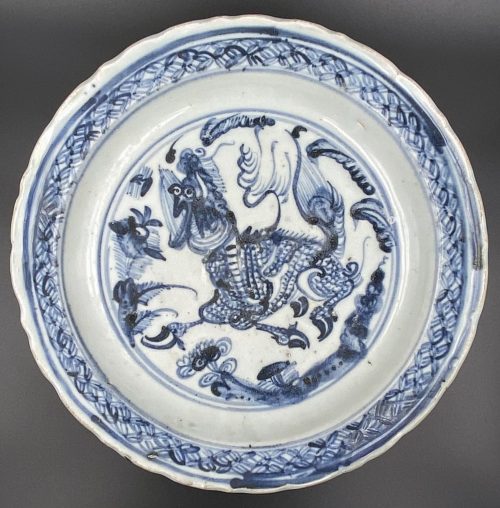 Footed plate with scalloped rim, centre decorated with running yak or another even-toed animal among flowers, jewel diaper pattern to the inner lip; foliage motif to the outside is bordered with foliage above and lotus leaves below. Porcelain with underglaze blue decoration. Ming Dynasty [大明] (1368 – 1644); Wanli Era (1572 – 1620); Late 16th – Early 17th century. Diameter: 25.5 cm; Height: 4.2 cm
Footed plate with scalloped rim, centre decorated with running yak or another even-toed animal among flowers, jewel diaper pattern to the inner lip; foliage motif to the outside is bordered with foliage above and lotus leaves below. Porcelain with underglaze blue decoration. Ming Dynasty [大明] (1368 – 1644); Wanli Era (1572 – 1620); Late 16th – Early 17th century. Diameter: 25.5 cm; Height: 4.2 cm -
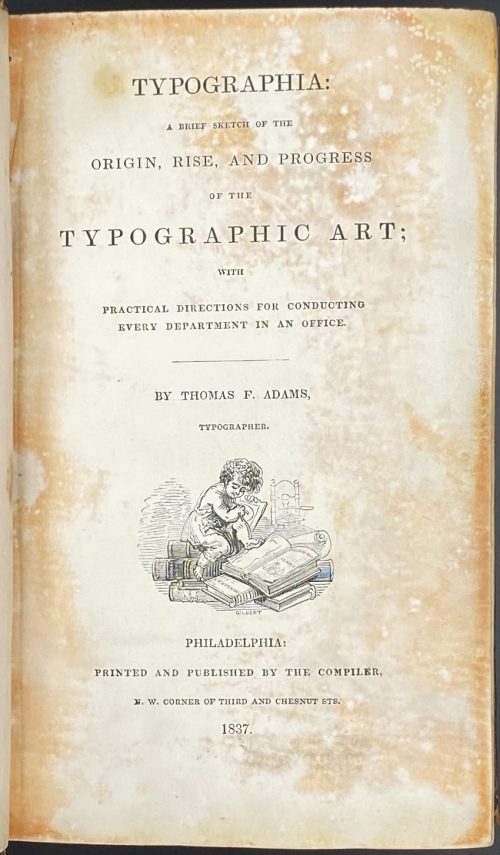 Title: TYPOGRAPHIA : | A BRIEF SKETCH OF THE | ORIGIN, RISE, AND PROGRESS | OF THE | TYPOGRAPHIC ART; | WITH | PRACTICAL DIRECTIONS FOR CONDUCTING | EVERY DEPARTMENT IN AN OFFICE. | BY THOMAS F. ADAMS, TYPOGRAPHER. | {vignette} | PHILADELPHIA: | PRINTED AND PUBLISHED BY THE COMPILER, | N. W. CORNER OF THIRD AND CHESNUT STS. | 1837. || Pagination: Engraved frontispiece w/guard, t.p. / blank, [1-3] 4-372 [8], incl. Index and Directions to binder. Collation: 12mo; 1-31(6). Binding: contemporary full brown speckled calf, flat spine bands with gilt double-fillets, dark brown lettering label. Note: Plagiarism of John Johnson's (British, 1777 – 1848) book Typographia, or, The printers' instructor published in London by Longman, Hurst, Rees, Orme, Brown & Green in 1824. .
Title: TYPOGRAPHIA : | A BRIEF SKETCH OF THE | ORIGIN, RISE, AND PROGRESS | OF THE | TYPOGRAPHIC ART; | WITH | PRACTICAL DIRECTIONS FOR CONDUCTING | EVERY DEPARTMENT IN AN OFFICE. | BY THOMAS F. ADAMS, TYPOGRAPHER. | {vignette} | PHILADELPHIA: | PRINTED AND PUBLISHED BY THE COMPILER, | N. W. CORNER OF THIRD AND CHESNUT STS. | 1837. || Pagination: Engraved frontispiece w/guard, t.p. / blank, [1-3] 4-372 [8], incl. Index and Directions to binder. Collation: 12mo; 1-31(6). Binding: contemporary full brown speckled calf, flat spine bands with gilt double-fillets, dark brown lettering label. Note: Plagiarism of John Johnson's (British, 1777 – 1848) book Typographia, or, The printers' instructor published in London by Longman, Hurst, Rees, Orme, Brown & Green in 1824. . -
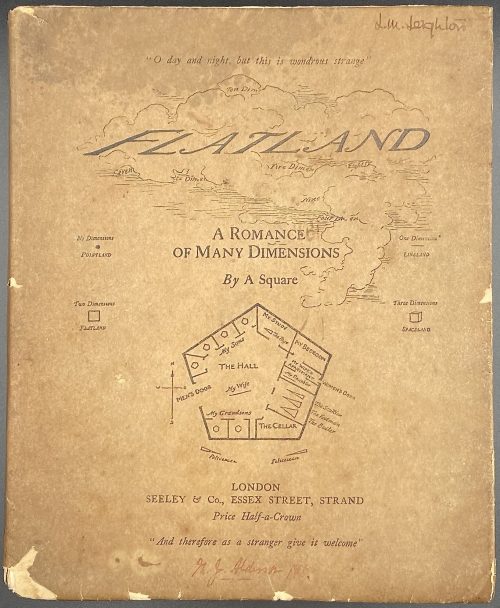 Title: FLATLAND | A Romance of Many Dimensions | With Illustrations | by the Author, A SQUARE | “fie, fie, how franticly I square may talk!” | NEW AND REVISED EDITION | LONDON | SEELEY & Co., 46, 47 & 48, ESSEX STREET, STRAND | (Late of 54 Fleet Street) | 1884 || Pagination: 2 blank leaves, [2] – h.t. / blank, [2] – t.p. / imprint., [2] – dedication / blank, [ix] x-xvi, [1, 2] f.t. / blank, [3] 4-102, 2 blank leaves; in-text woodcuts. Collation: [A]8 B-H8. Binding: original wrappers in pictorial parchment jacket, printed on laid paper, lower and lateral margins untrimmed. Note: This is the 2nd edition published the same year as the 1st, revised, as stated. I did not compare the two, neither I am planning to acquire the first 1st edition in a foreseeable future. This is a lifetime edition, handled by the Author himself, and that's enough for me to be quite happy.
Title: FLATLAND | A Romance of Many Dimensions | With Illustrations | by the Author, A SQUARE | “fie, fie, how franticly I square may talk!” | NEW AND REVISED EDITION | LONDON | SEELEY & Co., 46, 47 & 48, ESSEX STREET, STRAND | (Late of 54 Fleet Street) | 1884 || Pagination: 2 blank leaves, [2] – h.t. / blank, [2] – t.p. / imprint., [2] – dedication / blank, [ix] x-xvi, [1, 2] f.t. / blank, [3] 4-102, 2 blank leaves; in-text woodcuts. Collation: [A]8 B-H8. Binding: original wrappers in pictorial parchment jacket, printed on laid paper, lower and lateral margins untrimmed. Note: This is the 2nd edition published the same year as the 1st, revised, as stated. I did not compare the two, neither I am planning to acquire the first 1st edition in a foreseeable future. This is a lifetime edition, handled by the Author himself, and that's enough for me to be quite happy. -
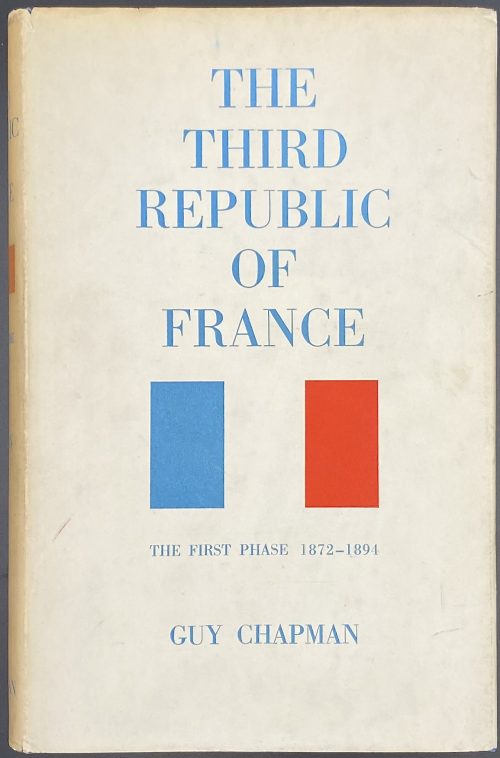 Title: THE | THIRD REPUBLIC | OF FRANCE | THE FIRST PHASE 1871–1894 | BY | GUY CHAPMAN | Sometime Professor of Modern History in the University of Leeds | LONDON | MACMILLAN & CO LTD | NEW YORK • ST. MARTIN’S PRESS | 1962 Pagination: [i-iv] v-xxii, [1] 2-433 [434 imprint]. Collation: 8vo; [A]8 B-Z8 2A-2D8 2E2 2E210. Binding: blue buckram, bronze lettering to spine, pictorial DJ. Publishing year 1963 according to worldcat. Author: Chapman, Guy Patterson (British, 1889 – 1972)
Title: THE | THIRD REPUBLIC | OF FRANCE | THE FIRST PHASE 1871–1894 | BY | GUY CHAPMAN | Sometime Professor of Modern History in the University of Leeds | LONDON | MACMILLAN & CO LTD | NEW YORK • ST. MARTIN’S PRESS | 1962 Pagination: [i-iv] v-xxii, [1] 2-433 [434 imprint]. Collation: 8vo; [A]8 B-Z8 2A-2D8 2E2 2E210. Binding: blue buckram, bronze lettering to spine, pictorial DJ. Publishing year 1963 according to worldcat. Author: Chapman, Guy Patterson (British, 1889 – 1972)


